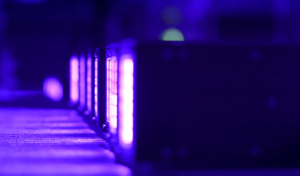After 20 years in business, here’s what we have learned from our customers
In the approximately 20 years since ultra‐violet light‐emitting‐diode (UV LED) curing lamps appeared in the market, there have been significant technological advances in LED efficiency and curing lamp performance. The initial challenges have been met and overcome, allowing UV LEDs to gain their place as a mainstream curing technology.
A Mission to Displace Mercury
Since 2002, Phoseon Technology’s goal has been to displace traditional mercury UV curing technology with more efficient solid-state LED while enabling new applications. Today, UV LED curing technology is no longer an emerging technology but an enabling technology−one that is bringing a host of advanced capabilities to a wide range of industrial applications. These advances and new capabilities are helping industrial processes be more productive, versatile and energy efficient.
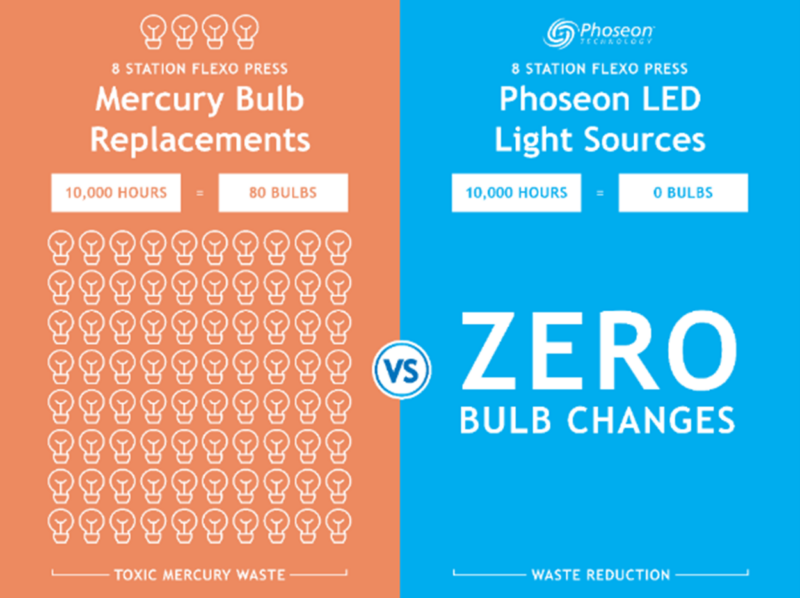
Why Have Users Adopted UV LED Curing?
For a new technology to gain acceptance in the market, the advantages need to be more compelling than the incumbent technology. The advantages of UV LED technology are quite significant compared to mercury UV and solve most of the issues that result from mercury lamp use. Here are some of the top reasons why Phoseon customers have upgraded from mercury to LED.
New Capability
Impresos Gráficos is a 26-year-old printing company in northern Mexico that manufactures and prints adhesive labels, PVC films for heat-shrinked sleeves, thermal tags, and other commercial printed products. The company prints approximately 300,000 labels a day. “I recommend the Phoseon system because it allows your company to be more competitive. This new technology will help grow your business and increase the kinds of new jobs that you are able to take on and the type of customers you are able to attract.” -Sergio Porras, Director, Impresos Gráficos
Sopano is an independent printing company located west of Paris, near Rouen, France, that manufactures and prints adhesive labels and rolls of receipts. Sopano decided to replace its aging mercury curing system with Phoseon UV LED ink curing solutions. As a result of the upgrade, they experienced significant benefits such as cost savings and the ability to support new markets. “Phoseon UV LED technology at Sopano brings us both the savings we expected and is opening up new markets for us.” – Laurent Charbonneau, president of Sopano.
According to Sonoco Institute, Phoseon’s LED curing technology allows them to keep up with the emerging market within the flexographic industry. LED technology allows them to run thinner films at a more stable speed. Phoseon Technology donated LED curing systems to Clemson University’s Sonoco Institute to help support the future generation of professionals in flexographic printing applications to have hands-on experience with UV LED curing, learning all the benefits and capabilities enabled with UV LED.
Focus Labels, based in Bingham, UK, can offer a wider range of print applications using LED curing without the need for changing systems and adding a lot of ancillary equipment. They are printing on a wider range of substrates, such as unsupported films, because the temperature is lower with LED compared to mercury. LED gives them the ability to look at new markets and new applications.
Operational Cost Savings
Central Valley Label experienced significant operational cost savings by upgrading from mercury to LED. Before switching to Phoseon UV LED curing technology, Central Valley Label was spending $40,000 to $50,000 per year on UV bulb replacement for their old UV mercury presses. When the company switched to the Phoseon UV LED solution, that expense was eliminated. Operational Costs Savings = Up to $50,000 per year
A Phoseon customer in Italy experienced more than 70% energy savings by upgrading from traditional mercury UV to Nexus ONE™ UV LED curing systems for flexographic printing. According to the customer, an 8-color UV flexographic press (430mm wide) that works on 2 shifts and consumes an average of 198,000kWh per year with traditional mercury UV. Under the same conditions, consumption with Phoseon UV LED is 58,000kWh. The annual saving for a single machine is therefore 140,000kWh x € 0.20 (average energy price per kWh in Italy) = € 28,000, to which are added to approximately € 10,000 of spare parts/ consumables for a total saving of approximately € 38,000 per year. Operational Costs Savings = >€ 38,000 per year (per printer)
According to Empire Screen Printing, operating expenses for a press with typical mercury vapor curing units costs around $34,000 a year (and the mercury bulbs used eventually end up in a landfill). However, the cost for the same press installed with UV LED curing units adds up to an energy efficient $658 per year. Empire Screen Printing – USA Operational Cost Savings $33,342 per year (per printer)
InDeco Serigrafia, located near Milan in Italy, stands out in the screen- printing market for luxury applications with its 30 years of experience and constant search for new, innovative solutions. Indeco did several retrofits switching from old UV mercury curing systems to a Phoseon high- performance UV LED curing solution. Besides the overall cost savings and operating benefits, the environmental friendliness of the solution was of paramount importance for Indeco, as this was requested by most the major consumer brands in the luxury sector. “We bought our first LED solution from Phoseon 7 years ago and it is still running. We were already very satisfied with the results. Indeco has always been looking for innovative technologies and Phoseon’s LED high power lamps are really performing extremely well both for big productions and at high speeds operations, “says Alessandra Musitelli.
Impresos Gráficos states, “We are delighted with our Phoseon UV LED system because we are now producing higher quality printing, in less time, and with lower overhead.”
Monson Fruit Company is a vertically integrated grower, packer, and shipper of high-quality fruit, based in Selah, WA. As part of the packing process, Monson Fruit Company has integrated UV LED technology to cure legally required digital inkjet markings on master fruit packaging cartons. With the installation of Phoseon UV LED curing technology, Monson Fruit’s production line can do nearly a case per minute, whereas before, each case could take up to 10 minutes to complete one label. These new production speeds were very impressive, says Sergio Llamas, IT Manager: “It’s been truly amazing to see the difference in performance. The Phoseon lamps cured over 1.8 million boxes of cherries this growing season, shipping to a global market. We plan to add a Phoseon UV LED lamp to all current and future Digital Inkjet lines, and we will be encouraging our industry-wide integration partners to do the same.”
PVS In-Store is a print shop in Portland, Oregon that is a proud owner of the EFI VUTEk GS3250LX flatbed printer with Phoseon UV LED curing. With LED curing technology (from Phoseon Technology) this hybrid printer offers media versatility at its peak. They can now run thinner materials through the machine without curling. PVS is unique in that the projects they create can print on substrates that are uncommon.
“The GS3250LX has enabled us to print on thinner substrates. This saves on both cost of materials and shipping. Now we can roll up output for shipping instead of using flat boxes, saving the customer about 30% on the job due to a lower cost of materials, as well as a 30% reduction in the cost of shipping. In addition, we are very excited about the new capabilities this printer has enabled, including the ability to print on aluminum and steel, wood, and artist cotton canvas. It will certainly be a growth engine for our business.” 30% cost savings on both cost of materials and shipping as a result of UV LED curing
Proven Reliability
Keysound Electronics utilizes UV LED curing of adhesives for micro- speaker assembly applications. “Our main consideration for choosing Phoseon Technology’s LED light source is the reliability of the equipment. Phoseon LED light sources have improved the quality of our products, providing customers with high-end products. At the same time, we have improved our production efficiency to meet the needs of our customers.”
PolyJet is one of the mainstream 3D printing technologies today. The PolyJet 3D printer sprays photosensitive resin material layer-by-layer onto the print tray until the parts are completed. Each layer of material is cured with ultraviolet light while being sprayed, and can be taken out and used immediately without secondary curing. Using the Phoseon FireEdge™ FE400 air-cooled curing light source, end customers can run stably for a long time (the model printing cycle of the model is more than 48 hours). The printing process with LED curing offers the highest efficiency, printing accuracy and yield can fulfill end customer’s stringent requirements.
Desmedt Labels has 32 print stations configured with Phoseon LED curing. What they like the most about LED curing technology is that it is very easy to use and highly reliable. Since they have had LED installed, they have never had to call for support. LED is highly reliable and offers the perfect curing solution.
Shanghai Belong Electronic Co., Ltd is engaged in industrial automation product integration for industrial electrical products. Belong Electronics decided to implement Phoseon’s UV LED curing systems to meet their increasing production challenges. Using Phoseon’s FireJet™ air-cooled LED curing light source, the end customer can consistently run the PCB silkscreen and solder mask printing processes for long periods of time with greater process stability, meeting the increasing production challenges with the highest efficiency, turnover rate, and yield.
Product Sustainability
Eticod decided to invest in UV LED technology to reduce CO₂ emissions and to make production more efficient. At the beginning of the year a Bobst M5 430, 10-color press with UV LED curing was successfully installed and put into operation. The machine consumes approximately 60% less electricity compared to mercury, which corresponds to an annual saving of approximately 84,000 kWh, eliminating 200 tons of CO₂. Aron Huc, son of company founder Jacek Huc, is very impressed with Phoseon UV LED curing technology: “Phoseon UV LED ensures constant and efficient curing on all colors and at all speeds. The fact that we do not need any replacement lamps or any other spare parts, as well as the longevity of the Phoseon UV LED lamps with an achievable lifetime of over 60,000 operating hours, give us security and predictability in our production. UV LED lamps do not emit any ozone, which means that no extraction system had to be installed. UV LED is not only good for the environment, but also has a very positive effect on the finances, sustainability and health and safety of our company.”
60% less electricity
200 tons of CO₂ per year eliminated (per year)
According to GM Graphix, UV LED offers instant on/off capabilities, making it ideal for South Africa’s power fluctuations. The press’ electrical consumption is currently 30 percent less than GM Graphix’s other flexo presses, Pieter Massyn, Owner, GM Graphix says. The solar panels at GM Graphix generate enough energy to run the press for 5.5 hours each day, which they would never be able to do with mercury UV. GM Graphics South Africa
Market Adoption
Printing
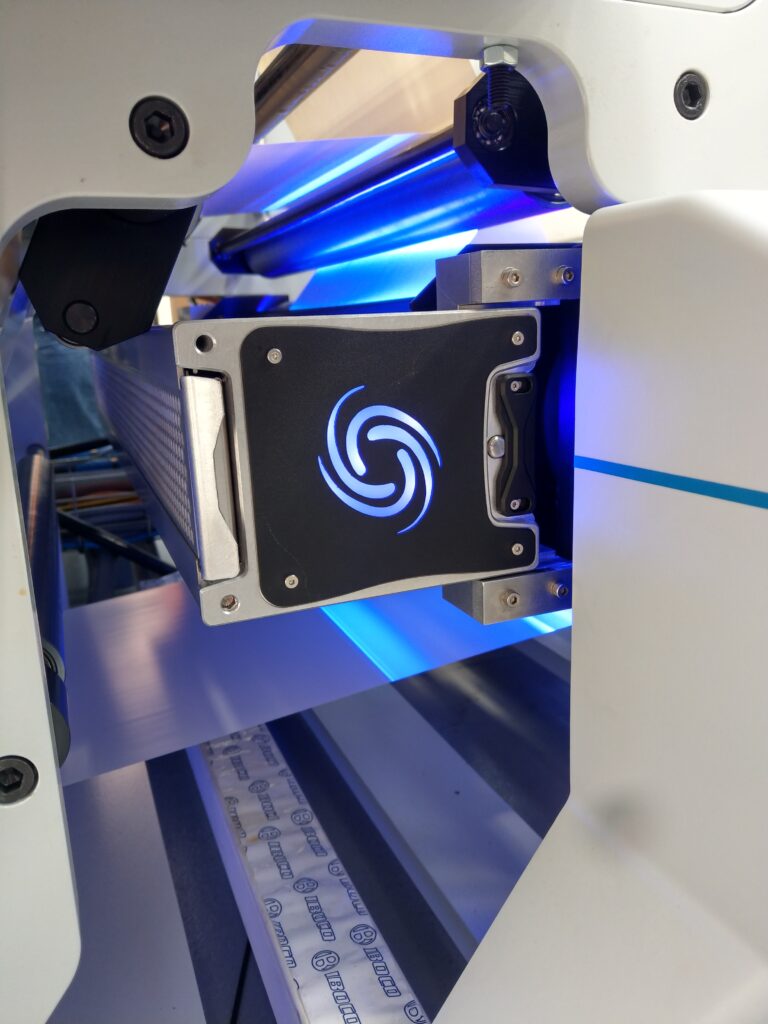
Typical of many new technologies there needed to be a “starting‐point” where a specific benefit of the new technology “out‐ weighs” the traditional method. UV inkjet applications (particularly on heat‐ sensitive substrates) were an early and clear success for the UV LED curing lamps. Continued development has enabled the UV LED based curing lamp to be the best overall solution for UV inkjet curing applications.
UV LED curing has been adopted in all areas of printing, from digital inkjet to screen, to flexography and even offset. End users are increasingly asking equipment manufacturers for LED options, and the market‐leading vendors are responding. Confronted with such exciting and rapidly evolving technology, system builders and end users are closely monitoring the ever‐changing UV LED curing landscape. Today, UV LEDs have gained their place as a mainstream curing technology throughout a wide range of printing applications.
Coatings
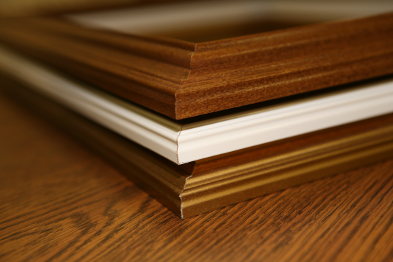
UV LED curing solutions are being utilized in the coating industry because they offer lower operating costs, enhanced system capabilities due to being a solid-state device, and environmental benefits of safer workplace environment and no hazardous materials. UV LED technology drastically reduces energy consumption and significantly reduces work-piece surface temperature. Machines can be made more compact due to small form factor; speed can be increased due to consistent UV output; and the diffuse nature of UV LED light can be used to more effectively cure shaped surfaces which previously required multiple lamps at various angles. UV curable coating applications include wood and vinyl, automotive, musical instruments, fixtures and many others.
Adhesives
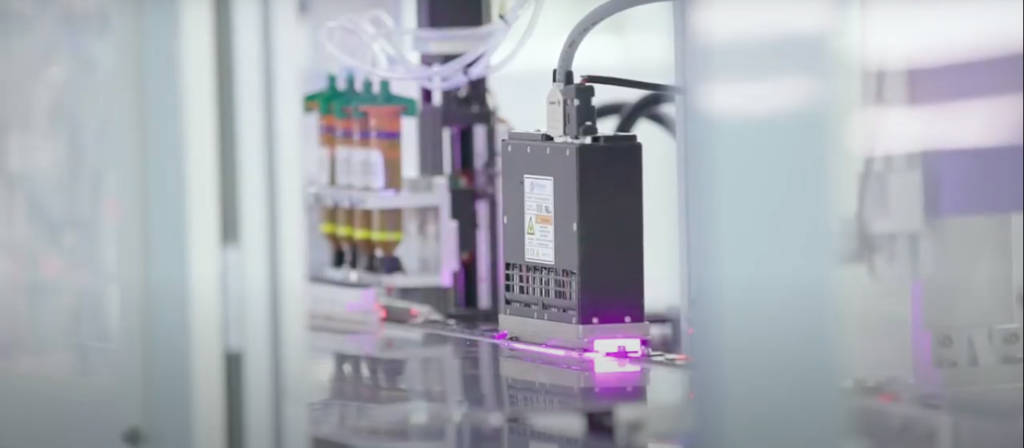
Adhesive bonding, sealing, and coating processes in factory assembly lines are rapidly upgrading to UV LED curing technology. UV Adhesives
are a great tool in modern assembly and manufacturing processes with UV LED electronic control and stability ensuring excellent results in a wide variety of UV LED adhesive applications from medical devices to the most advanced consumer electronics.
Ultraviolet light-emitting diode curing technology offers significant advantages compared to traditional mercury UV curing. As a result, adhesive bonding, sealing, and coating processes in factory assembly lines are rapidly upgrading to UV LED curing technology.
UV adhesive curing application segments include electronic assembly, automotive, medical, ammunitions, pressure-sensitive films, general assembly, and other manufacturing processes. UV LED curing technology is ideally suited for electronic assembly applications. The combination of high-energy UV LED sources with the appropriate adhesive enables increased productivity while also providing the ability to cure heat- sensitive materials. Today, many electronics manufacturers use UV LED curing in the production of products such as touchscreens, mobile phones, micro-speakers, and hard disk drives.
A More Sustainable Future
The mercury ban in manufacturing processes is growing globally. All the major brands are requiring environmentally sustainable processes from printers, converters, and other manufacturers. Now that LED has become a valid alternative to mercury, many large global companies are eliminating mercury from all their factories. A UV Lamp typically contain up to 250mg of mercury and each lamp needs to be replaced every 1500-3000 hours. Mercury poisoning causes damage to the central nervous system, kidneys, and many other organs.
The environmental benefits of UV LED curing are numerous. Phoseon customers have experienced energy savings up to 85 percent with the implementation of UV LED curing systems. With traditional UV curing processes, the tremendous heat associated with mercury UV lamps required a lot of electricity to operate. Mercury lamps produce ozone, which is a greenhouse gas and is for the operator to inhale, especially in a constricted space like a print shop. Air exhaust systems are required to extract the toxic fumes from the presses. These exhaust systems can be eliminated with UV LED curing. LED is the only sustainable choice for UV curing.
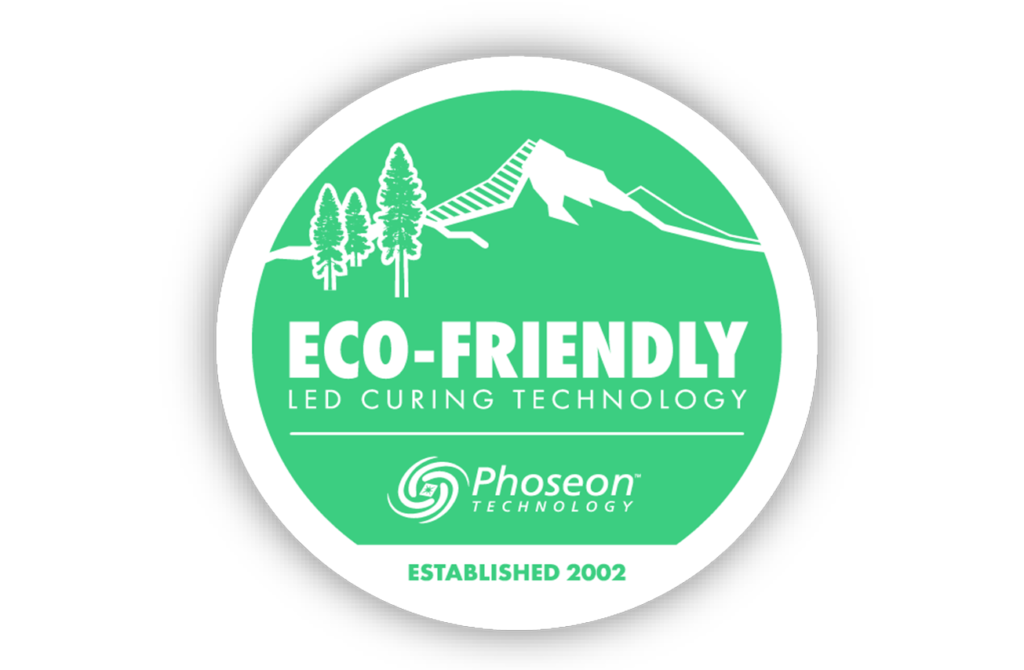
The Inventor of UV LED Curing
As the industry pioneer, Phoseon provides the broadest portfolio of LED- based solutions for drying inks, coatings, adhesives, and other UV sensitive materials through polymerization. With over 300 patents and trademarks protecting more than 150,000 units shipped, Phoseon has earned a worldwide reputation for innovation, quality, and reliability.
Phoseon provides LED curing solutions to a wide range of applications and market segments including labels and packaging, container decoration, digital printing, wire and fiber coatings, electronics, automotive assembly, medical devices, wood furniture, and many more.
Tags: UV LED Industrial Curing | UV LED Curing | LED Light Sources | 100% LED Focused | FuturePrintCategories: Manufacturing | UV LED Curing by Phoseon | Corporate
